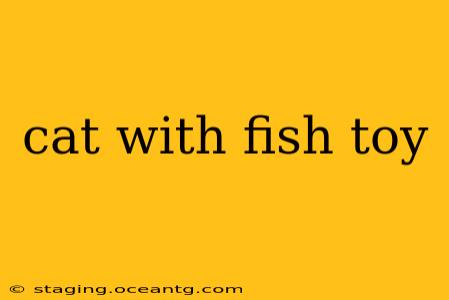Cats and fish toys. It's a classic combination, a seemingly timeless fascination that has captivated cat owners for generations. But why are cats so drawn to these wiggling, fin-flapping replicas of aquatic creatures? The answer is multifaceted, blending instinctual behaviors with the simple joys of play. This article delves into the reasons behind this captivating connection, exploring the science and psychology behind a cat's love for fish toys.
Why Do Cats Love Fish Toys?
The allure of fish toys for cats lies in a clever blend of factors that tap into their natural hunting instincts and provide stimulating playtime. The movement, the unpredictability, and even the visual appearance of fish toys mimic the characteristics of real prey, triggering a powerful response in a cat's brain. Let's break it down:
Mimicking Prey:
The most obvious reason is the inherent connection to hunting. Cats are natural predators, hard-wired to chase, stalk, and pounce on moving objects. Fish toys, with their erratic movements and often bright colors, perfectly replicate the characteristics of small, fleeing prey. This triggers their predatory instincts, providing a satisfying outlet for their natural hunting behaviors.
The "Catch" and the Reward:
The act of capturing the toy, even a simple batting motion, provides a sense of accomplishment and reward for the cat. This positive reinforcement strengthens the association between the toy and the positive feeling, leading to repeated play. Many fish toys even incorporate sounds or crinkling materials to further enhance the experience and mimic the sounds of struggling prey.
Enrichment and Mental Stimulation:
Beyond the immediate physical gratification, fish toys offer valuable mental stimulation. The unpredictable nature of their movement keeps cats engaged and prevents boredom. This is especially important for indoor cats who may lack the opportunity to hunt actual prey. A stimulating playtime session with a fish toy helps to prevent behavioral problems that can stem from under-stimulation.
What Makes a Good Fish Toy?
Not all fish toys are created equal. Choosing a high-quality toy will ensure your cat enjoys engaging playtime and doesn't experience frustration. Here are some factors to consider when selecting a fish toy:
- Durability: Cats can be rough players! Opt for toys made from sturdy, non-toxic materials that can withstand vigorous chewing and play.
- Movement: The toy should move in a way that mimics the unpredictable movements of real fish. Consider spring-loaded, battery-operated, or interactive toys that offer varied motion.
- Safety: Always supervise playtime to ensure your cat doesn't swallow any small parts. Avoid toys with potentially harmful materials or sharp edges.
- Variety: Provide a variety of fish toys to keep your cat engaged and prevent boredom. Different textures, sounds, and movements can add to the fun.
What Other Types of Toys Do Cats Like?
While fish toys are a favorite for many cats, other types of toys can also provide enrichment and satisfy their hunting instincts. These include:
- Feather wands: The erratic movement mimics fleeing birds.
- Laser pointers: The fast-moving dot provides a stimulating chase game (though remember not to shine it in their eyes!).
- Crinkle toys: The surprising sound and texture stimulate play.
- Mice and other small stuffed animals: These offer a softer alternative to the more active fish toys.
How Often Should I Play With My Cat?
Playtime is crucial for your cat's physical and mental well-being. Aim for at least two interactive play sessions per day, each lasting around 15-20 minutes. This will help them burn off energy, stay active, and strengthen your bond.
Are There Any Dangers Associated With Fish Toys?
While generally safe, some precautions should be taken:
- Supervision: Always supervise your cat during playtime to prevent ingestion of small parts.
- Material: Choose toys made from non-toxic materials.
- Durability: Replace damaged or worn-out toys immediately.
By understanding your cat's innate hunting instincts and providing stimulating playtime with appropriate toys, you can ensure your feline friend remains happy, healthy, and entertained for years to come. Remember, a happy cat is a healthy cat!
